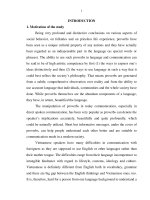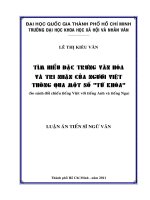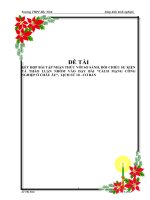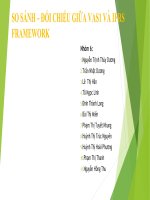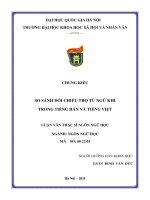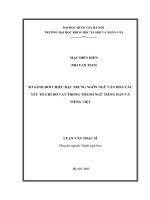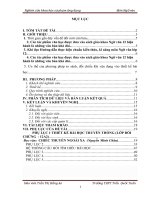so sánh đối chiếu ngôn ngữ và văn hóa qua tục ngữ anh - việt
Bạn đang xem bản rút gọn của tài liệu. Xem và tải ngay bản đầy đủ của tài liệu tại đây (311.38 KB, 55 trang )
1
INTRODUCTION
1. Motivation of the study
Being very profound and distinctive conclusions on various aspects of
social behavior, on folktales and on priceless life experience, proverbs have
been seen as a unique cultural property of any nations and they have actually
been regarded as an indispensable part in the language (as special words or
phrases). The ability to use such proverbs in language and communication can
be said to be of high artistic competence by first (1) the ways to express one’s
ideas distinctively and then (2) the ways to use language in such a way that it
could best reflect the society’s philosophy. That means proverbs are generated
from a subtle, comprehensive observation over reality and from the ability to
use accurate language that individuals, communities and the whole society have
done. While proverbs themselves are the abundant components of a language,
they have, in return, beautified the language.
The manipulation of proverbs in today communication, especially in
direct spoken communication, has been very popular as proverbs can denote the
speaker’s implications accurately, beautifully and quite profoundly, which
could be naturally utilized. Short but informative messages, under the cover of
proverbs, can help people understand each other better and are suitable to
communication mode in a modern society.
Vietnamese speakers have many difficulties in communication with
foreigners as they are supposed to use English or other languages rather than
their mother tongue. The difficulties range from their language incompetence to
intangible hindrance with regard to lifestyle, customs, ideology and culture.
Vietnamese is definitely different from English both in vocabulary, grammar
and there are big gap between the English thinkings and Vietnamese ones, too.
It is, therefore, hard for a person from one language background to understand a
2
proverb spoken in another language background. It will surely be harder for
a speaker to choose a certain proverb to fully express his ideas.
Language is, however, a special social phenomenon as it was born and
developed in a close relation with social development and human’s lives. As
human beings are social creatures, they would share similar aspects in their
thinkings when they have experienced similarities in society’s organization and
development despite being in different geographical features, in various
customs. Beside their differences, it is strongly believed that both Vietnamese
and English proverbs have many things in common.
Despite spending a little time in teaching translation skill to English
majored students in Dong Thap University, the writer has realized that the
students here have faced thousands of difficulties in dealing with proverbs when
carrying out their translating tasks. In a search for better personal
understandings of this special linguistic phenomenon as well as a desperate
hope to help students work faster and better in their translation, the writer is
determined to make this a scientific study.
2. Research objectives
This study is ultimately aimed at finding the similarities and differences
between linguistic and cultural aspects in English and Vietnamese proverbs.
Therefore, the followings will surely be made clear in the study:
- General characteristics of English proverbs in term of linguistic aspects
and culture aspects.
- General characteristics of Vietnamese proverbs in term of linguistic
aspects and culture aspects.
- The similarities and differences on linguistic aspects and culture aspects
between English proverbs and Vietnamese proverbs
3. Research questions
Based on the given objectives, this study is going to give the answers to the
following questions
3
1. What are the characteristics of English proverbs and
Vietnamese ones in term of linguistic aspects and culture aspects?
2. How are English proverbs and Vietnamese ones similar and different
regarding to linguistic and culture aspects?
4. Research methodology
The research methods to be applied in this study include:
Quantitative and qualitative analysis: this will be used for reading and
categorizing typical English and Vietnamese proverbs (the equivalents)
Contrastive analysis: Proverbs in English and Vietnamese will be
compared and contrasted in the aspects of linguistics and culture to find
out their similarities and differences.
5. The significance of the study
Contrastive research is always a topical question in the field of
contrastive linguistics, as hundreds of problems would arise once the
differences and similarities between the two accidental languages are taken into
account. The similarities and differences between English and Vietnamese
proverbs in the aspects of linguistics and culture will have valuable contribution
to the current work of linguistics research and language teaching and learning.
Learning language and culture can be done in different forms and through
various sources and proverbs are among these sources as proverbs are of high
frequency of use in daily communication and are means to express the
speakers’ culture, namely knowledge of the world, their experience and attitude
to life and the society. Because no relevant studies in Vietnam so far and only
some limited articles in other countries have been published, it’s necessary for the
topic to be dealt with for a better understanding of linguistics and culture, which
will give valuable contribution to the teaching and learning of foreign languages.
The findings of this study can be used a useful and reliable reference
material for the English majored students or those who are engaging their
approaches to foreign culture studies, mainly British and American culture. The
4
findings also provide the rich source of reference for the students who have
encountered tremendous hindrance in learning translation. Under the light of
intensive analysis on the proverbs, the similarities and differences in British culture
and Vietnamese one will surely help bring students out of the maze of uncertainty
whenever they deal with culture matters.
Finally, the result of the study will be an important contribution to the
movement of self study-based teaching and learning renovation, proposed and
encouraged by the school. At the same time, the study will make a humble
contribution to future intensive studies on proverbs of Vietnamese and English.
6. The organization of the study
Apart from the Table of Content, Appendices, this study is structured as follow
Introduction
1. Motivation of the study
2. Research objectives
3. Research questions
4. Methodology
5. The significance of the study
6. The organization of the study
Chapter 1 English – Vietnamese proverbs and their characteristics
1.1 Definition of proverbs
1.2 English proverbs and their typical characteristics
1.2.1 Typical linguistic features
1.2.2 Typical culture features
1.3 Vietnamese proverbs their characteristics
1.3.1 Typical linguistic features
1.3.2 Typical culture features
Chapter 2 Similarities between the proverbs
2.1 Similarities in linguistic aspects
2.1.1 The use of phrases
2.1.2 The use of clauses/sentences
2.1.3 The use of non-subject sentences
2.1.4 The use of reiteration
2.1.5 The use of contrast
2.1.6 The use of similes
2.1.7 The use of rhyme
5
2.2 Similarities in culture aspects
2.2.1 Thinking styles
2.2.2 Humoristic
Chapter 3 Differences between the proverbs
3.1 Differences in culture aspects
3.1.1 Differences in the uses of pronouns
3.1.2 Differences in the structures
3.1.3 Differences in the proverb topics
3.2 Differences in culture
3.2.1 Agriculture based economy versus non-agriculture based
economy
3.2.2 The English language versus the Vietnamese language
Conclusion
6
CHAPTER I
PROVERBS AND THEIR TYPICAL CHARACTERISTICS
1.I. Definitions of proverbs
In the context of linguistic practice and folk application, proverbs have
been defined in various ways although they share one thing in common, e.g
“short rhythmus sentences that summarize people’s life experience, moral
values and reality of daily life” (translated)
1
. More detailed definitions, both
by Vietnamese linguists and by English counterparts, are introduced below.
“Tục ngữ là một câu nói hoàn chỉnh, gọn sắc, xuôi tai, diễn đạt trọn vẹn
một ý nghia mà nội dung thuộc về những kinh nghiệm đời sống, kinh nghiệm
lịch sử xã hội của nhân dân” (Lương) “A proverb is a complete sentence that is
short and pleasant to ear. They express something the meaning of which is
about people’ life experience and socio historical experience” (Luong)
“Tục ngữ là thể loại văn học dân gian nhằm đúc kết kinh nghiệm, tri thức
của nhân dân dưới hình thức những câu nói ngắn gọn, súc tích, có nhịp điệu, dễ
nhớ, dễ truyền”. (Tuấn) “A proverb is a kind of fork lore literature that summarizes
people’s experience and knowledge in the form of a short and concise sentence which
is rhythmus, easy to be learned, memorized and propagated”
“Tục ngữ thông thường được hiểu là những câu dùng để phản ánh các tri
thức và kinh nghiệm dân gian của dân tộc về giới tự nhiên và xã hội, qua đó
đồng thời là lời khuyên về cách xử thế và đạo lý làm người” (Dân) “By general
understandings, proverbs are sentences to express the nation’s knowledge and
experience about the nature and society. At the same time, they give advice on
how to behave and practice moral principles.”
In English, proverbs are defined as follow.
1
Từ điển Tiếng Việt, Viện ngôn ngữ học, Nhà xuất bản Khoa học xã hội, 1992, trang 1043
7
“A proverb is a short, pithy saying
in frequent and widespread use,
expressing a well-known truth or fact.”(2)
2
, or “A proverb is a traditional saying
which offers advice or presents a moral in a short and pithy manner”
3
In many other documents, we found that proverbs are defined in the
English language as follows:
A proverb is a short, generally known sentence of the folk which contains
wisdom, truth, morals, and traditional views in a metaphorical, fixed and
memorizable form and which is handed down from generation to generation”
(Mieder 1993, p. 5).
“A proverb is a short sentence of wisdom” (Mieder 1993, p. 5)
“The proverb is a traditional, conversational, didactic genre with general
meaning, a potential free conversational turn, preferably with figurative
meaning” (Norrick 1985, S. 78).
Proverbs are in general originated from people’s real life, in their
production and struggle for existence. They are produced by people, in either
daily conversations or in literature works.
There is a close relationship between a proverb’s form and its content as
a proverb usually has two layers of meanings, namely the literal sense and the
figurative sense. Proverbs are rich in producing images, that is to say they
picture out many figurative images, which are created thanks to similes,
personification and metaphor.
In term of their syntactic features, proverbs are rhythmically structured in
rhymes including close rhymes and medial rhymes. When they are cited, they
are separated by syllabled fragments or words. The opposite between the
phrases in a proverb gives rise to harmonious balance and a steady construction.
Proverbs can include just only one phrase with one sole judgment or several
phrases with different judgments
2
Từ điển bách khoa toàn thư, Nhà xuất bản Houghton Mifflin Company, 1980, trang
3
The Oxford Concise Dictionary of Proverb, Simpson, 1998).
8
Born in different aspects of society including human’s literature,
daily work and forklore tales, proverbs then are of significant importance. First,
proverbs are seen as precious treasure of people’s codes of behavior in their
relations among family members, individual-to-individual, individual to
society, individual to the nature. In family, such principles as “cha làm sao con
bào hao làm vậy” (as the old cocks crows, so does the young), or “cha nào con
nấy” (like father, like son), “anh em như thể tay chân” (brothers are like hands
and feet) are almost applied all the time.
Second, proverbs are a social phenomenon as each individual, no matter
what he/she will be, either the educated one or the uneducated one, has his/her
own stock of proverbs and tends to use them in their daily life. The proverbs in
use are said to best suit the people’s living conditions, working environment,
and be appropriate with their life experience and ideology. They all have
created a rich stock of proverbs which best reflect their education, awareness
and ideology in a certain historical period.
The third function of proverbs can be expressed in their possibility of
being used in communication. As they are summaries of high condensation,
generalization, proverbs can bring forth telling effectiveness in daily
communication.
4
Proverbs are short in words but long in meaning, simple in
form but quite profound in implication so they are favored by almost all
speakers. Proverbs have even been used as “vocabulary” to write interesting
stories like that of “Thừa một con thì có”
5
. Using proverbs in communication is
really an art of language use.
1.2. English proverbs and their characteristics
There are many rhetoric techniques in English proverbs, for instance
similes, metaphor, metonymy, synecdoche, personification, antithesis, contrast,
repetition, alliteration, rhythm and so on. These rhetoric techniques make the
form of English proverbs terse, the content rich, and the meaning deep. As we
4
A Proverb in the hand is often worth a thousand words (Horace Reynolds, 1959)
5
Vietnamese popular fork tales
9
know, the figures can be divided into two kinds, one is on the language
(about vocabulary and sentence); the other is on the thought (about material and
condition). The first kind includes antithesis, contrast, repetition, alliteration,
rhythm and so on; and the second one includes simile, metaphor, metonymy,
synecdoche, personification etc.
1.2.1 Typical linguistic features
The first feature of proverbs, in term of thier linguistic aspect, is thier
conciseness and clearness as proverbs are fixed in their structure. They are less
in words but they express more meaning. The second feature of proverbs can be
seen in their symmetrical sentence pattern. In term of structure, the proverbs
have an obvious characteristics, that is clause or sentence patterns is
symmetrical. No matter in sight or language sense, it always appears in
harmony and unity. Take these proverbs for example:
Easy come, easy go
No pains, no gains
Ill got, soon spent
It’s six of one and half a dozen of another.
The two parts of the proverbs above are symmetrical in structure, with the word
class being similar, and the syllables being almost the same. Some of them use
the similar thing to replenish each other; the others use the completely different
to forms strong contrast. Moreover, some proverbs use the harmony to have the
syllable well proportioned, and full of music beauty.
The third feature of English proverbs is that many rhetoric techniques such as
repetition, antithesis, and metaphor are used. In the first place, repetition brings
about deeper meaning and strengthens the proverbs’ tone. For example,
Soon ripe soon rotten
Out of debt, out of danger
Diamond cut diamond
Like cure like
10
The use of antithesis can make sentence harmonious and symmetrical,
and make know the dialectic relationship among things, such as: where there's
smoke, there's fire; waste not, want not. Lastly, the use of metaphor in proverbs
is more common, which makes sentences more active and turn to life as
sophisticated moral advice like “Love me, love my dog”; “Never offer to teach
fish to swim.”
In term of grammatical structure, English proverbs are usually in these
compositions
- If clauses
If you sell the cow, you sell her milk too
If one will not, another will
If you can not bite, never show your teeth
If the bed could tell all it knows, it would put many to the blush.
If you touch pot, you must touch penny
- Adjective clauses
He that has a great nose thinks everybody speaks of it
He that has no children knows not what love is
He that has money has what he needs
He that is warm thinks all so
He who laughes last laughes best
He who says big does a little
He who makes no mistakes makes nothing
He who rides on a tiger can never dismount
1.2.2 Typical culture features
It is always a hard job whenever we are supposed to talk about culture as
culture is not simply what we can see, what we can touch or read. Under a very
deliberate analysis and discussion, Tran Ngọc Them concluded that “Culture is
reciprocal system of material and spiritual values created and accumulated by
human beings through their daily activities in the context of mutual interaction
11
between people to the society and environment” (translated).
6
Accordingly, culture is all things related to human beings, and English culture
has something to do with English people, their living environment. In about
1000 proverbs, we presumably propose the following features that are reflected
by proverbs.
1.2.2.1 Proverbs reflecting weather conditions
It’s obvious that weather is reflected in proverbs because this element is
an indispensable part in the lives of almost all peoples in the world. For the
English people, weather conditions are of significant meanings to them as
“Britain is well-known for the bad and changeable weather with a lot of rain
and very thick fog”
7
. In England, it rains a lot, with the average annual rainfall
of 800 mm to 1.000 mm. Besides, England has suffered from the very
unpleasant stage of fog, so much serious that this country has long been called
“the country of fog”. Consequently, many proverbs express the weather
conditions or words of weather condition are used as the signified for the other
things in the society. “It never rains but it pours” is the best proverb
demonstrating England’s bad weather condition as well as people’s sufferings
beside the other ones.
Rain, Rain, go away, come back another day
South Wind Surely Brings Us Rain, the North Wind Blows It Back Again
A quarrelsome wife is like a constant dripping on a rainy day.
The English people have much experience in giving forecast on weather
conditions.
If you sneeze three times within a second, the next day will be sunny
Many flowers close up before a storm, pine cones do too
Clear moon, frost soon
Rainbow in the morning gives you fair warning
Halo around the sun or moon, rain or snow soon
6
Trần Ngọc Thêm, Cơ sở văn hóa Việt Nam, Nhà xuất bản Giáo dục, 1998, trang 10.
7
Dương Anh Lâm, British culture, Nhà xuất bản Giáo dục, 2005, trang 25
12
Red Sky at night, sailor's delight. Red sky in the morning, sailor
take warning.
The north wind bringeth forth rain
Seagull, seagull, sit on the sand. It’s never good weather when you’re on the
land
As the inclement weather has been a great nuisance to their lives, weather
is known as the common conversation topics for the English people. They
always wish to get rid of bad weather as soon as possible and they are pleased
to see that the weather has changed for the betterment.
Rain before seven, fine before eleven
March winds and April showers bring forth May flowers
1.2.2.2 Proverbs reflecting English people’s work and working styles
For every individual, community or nation, jobs are of the utmost
meaning, not just for earning livings but for the purposes of prosperity and self-
improvement. By asserting that “work of any kind is good”, the English people
seem to find jobs for their own livings despite the State well –organized welfare
system
8
. The sense of being industrious enables the English people to overcome
difficulties in life, to take hardship and endurance, and to highly appreciate
those who have the true sense of workmanship, the right attitude to work.
No pains no gains
No bee no honey
A handful of trade is a handful of gold
Lazy hands make a man poor, but diligent hands bring wealth
All things are difficult before they are easy
By hard labor, a man will succeed
On the other hand, they dislike being idle and consider being idle is a
kind of social crime or even calamity.
The devil finds work for idle hands to do
8
“Britain is a welfare state with a wide benefit system meant to help people”, British culture, Duong Lam Anh,
Nhà xuất bản Giáo dục, 2005, trang 94.
13
Idleness is the root of all evils
An idle man is the devil’s booster
An idle person is the devil’s play follow
If you don’t work, you shan’t eat
They think that “he who works his land will have abundant food, but the
one who chases fantasies will have his fill of poverty”, and that “a man without
job will live in poverty”. It should have been the poverty that gives them bad
prospects to the future, so the words “poor”, “poverty” have regularly been
reiterated the in their proverbs.
The ruin of the poor is their poverty."
Poor is he who works with a negligent hand
The poor is hated even by his neighbor
All the brothers of a poor man hate him
He who loves pleasure will become a poor man
Do not rob the poor because he is poor
Poverty and shame will come to him who neglects discipline
For the heavy drinker and the glutton will come to poverty
Poverty is the result of laziness
Loving riches and pleasure (greed) leads to poverty
The English people hate being poor, so they have a very hardworking
style by first observing rule of punctuality, like that of “Time and tide wait for
no man”, then saving time because “Time is gold”. Whenever they do
something, they want to do it wholeheartedly and finish it quickly and properly.
Never put off till tomorrow what you can do today
First come first served
It’s the early bird that catches the worm
One who has the reputation of an early riser may safely lie in bed until
noon.
Regarding to particular jobs, the English people are known to have
started their earliest occupations on castle raising, fishing and trading
14
respectively
9
. In the United Kingdom’s history of nation birth, this
country is originally formed by several peoples
10
, with the Celtic being a human
group that led nomadic life to enjoy expanding land and traveling. In their
proverbs, there appear many names of animals whose lives are closely
connected to the nomadic living styles, such as “horse”, “camel”, “cow”, “ass”,
“monkey”, “dog”, “bird”, and other elements belonging to the natural
environment, including “tree”, “grass”, “water”, “land”. Here are the examples.
- Animals
A camel is a horse designed by a committee
All lay loads on a willing horse
Its too late to shut the stable door after the horse has bolted
Life is like a horse race there are winners and losers
Never look for a gift horse mouth.
The horses of hope gallop, but the asses of experience go slowly
Every Ass Loves to Hear Himself Bray
The Ass Loaded With Gold Still Eats Thistles
He who steals an egg will steal an ass.
It’s the last straw that breaks the camel’s back.
Barking dogs never bike
Let sleeping dogs lie
Every dog has his day
Take a hair of the dog that bites you.
If you lay down with dogs you will come up with fleas.
Only mad dogs and Englishmen go out in the midday sun
9
History of Britain – time line and fact, Mandy Barrow, Woodland Junior School, Hunt Road, Ton Bridge
Kent, UK
10
The English is the mixture of many people living in England over thousands of years ago. They are mainly of
Anglo – Saxon descent The Welsh, the Scots, and the native Irish are of Celtic origin Britain is a welfare
state with a wide benefit system meant to help people”, British culture, Duong Lam Anh, Nhà xuất bản Giáo
dục, 2005, trang 32.
15
A bird can sing with a broken wing, but you can’t pluck feathers off
a frog
A bird in the hand is worth two in the bush
Birds of a feather flock together.
Fine feathers make fine birds
God gives every bird its food, but does not always drop it into the nest
- Environment elements
The grass is always greener on the other side of the fence
Still waters run deep
A scalded cat fears cold water
Blood is thicker than water
No matter how long a log stays in the water it does not become a
crocodile
Before enlightenment, I chopped wood and carried water; after
enlightenment, I chopped wood and carried water.
A good tree brings forth good fruit
He that plants a tree plants for posterity
Plant the crab tree where you will, it will never bear pippins
The fruit does not fall far from the tree.
The higher the tree, the sweeter the plum
In the land of hope, there is never any winter
He who works his land will have abundant food, but the one who chases
fantasies will have his fill of poverty
1.3 Typical characteristics of Vietnamese proverbs
1.3.1 Typical linguistic features
As defined by many linguists, one common but important feature of
Vietnamese proverbs is the concrete structure, eg. they are well-structured with
two prominent aspect.
13.1.1 Conciseness
16
Vietnamese proverbs are usually in simple composition, ranging from
three words or longer but they are in general very short. In reality, some
proverbs are quite short like
Tham thì thâm
Túng thì tính
Some are longer, ranging form eight or ten words. For example
- Rượu ngon bất luận be sành
Áo rách khéo vá hơn lành vụng may
The most common structure of Vietnamese proverbs are of short ones, with
the structure of four, six or eight words that come out in pairs of equal
number.
Sớm nở tối tàn
Ăn vóc học hay
Cha nào con nấy
Bỏ thì thương, vương thì tội
Khôn ba năm, dại một giờ
Sống để bụng, chết mang theo
Giàu vì bạn, sang vì vợ
Đói ăn vụng, túng làm càng
Hùm chết để da người ta chết để tiếng
Một nghề cho chin còn hơn chin nghề
Bán anh em xa mua láng giềng gần
Sống gần nhà giàu đau răng cho ăn cốm
In a proverb itself, there is no redundant words and they altogether
express a complete thought or idea.
1.3.1.2 The symmetry
The presence of symmetrical structure is one of the unique features of
Vietnamese proverbs. The symmetry creates a balance between the phrases
17
within a proverb through equal number of words, ranging from two,
three, four, five to even seven words. Look at these examples
- The symmetry of two words
Máu chảy ruột mềm
Môi hở răng lạnh
Khác máu tanh lòng
Lớn thuyền lớn sóng
Khẩu Phật tâm xà
- The symmetry of three words
Chờ được vạ má đã sưng
Sai con toán, bán con trâu
Sông có khúc, người có lúc
Đói ăn vụng túng làm càn
- The symmetry of four words
Ba ông thợ da bằng Gia Cát Lượng
Chó cậy gần nhà, gà cậy gần vườn
Hùm chết để da người ta chết để tiếng
Có chí làm quan có gan làm giàu
- The symmetry of five words
Nuôi lợn ăn cơm nằm nuôi tằm ăn cơm đứng
Đánh kẻ chạy đi ai đánh người chạy lại
Mèo lớn bắt chuột to, mèo con bắt chuột nhỏ
- The symmetry of six words
Thua kiện mười bốn quan năm, được kiện mười lăm quan chẵn
Của làm ra để trên gác, của cờ bạc để trên cây
- The symmetry of seven words
Giàu không hà tiện khó liền tay, khó không hà tiện khó ăn mày
The symmetrical structure in proverbs may help the readers learn,
remember and use proverbs better. As the two phrases contain the same
18
numbers of words, the readers can probably find out if they have read
the correct proverbs. This feature also gives rise to another feature in
Vietnamese proverb, which is paralleled structure.
1.3.1.3 Paralleled structures
In his book, Nguyen Nha Ban
11
asserted that “Proverbs are the
condensed statements and thus they can be distinguished from the other
normal statements by their presence of paralleled structures”. Parallelism is
the repetition of grammatical units within the linguistic components that
make up the proverbs. In term of composition, parallelism is created thanks
to the coincidence of the same grammatical units, including parts of speech,
phrases, and clauses.
Bá nhân bá tính (phrases)
Ăn ốc nói mò (phrases)
Cốc mò, cò xơi (clauses)
Hoa có thời, người có lứa (clauses)
Còn da lông mọc, còn chồi nên cây (clauses)
However, in Vietnamese proverbs, parallelism is not simply the
repetition of the same grammatical units. Actually, in paralleled structures,
different means of linguistic functions are used, including contrast of tone,
ideas. Take these proverbs as examples
Cầu được, ước thấy (được – ước)
Có tiền mua tiên cũng được (tiền – tiên)
Kẻ tám lạng, người nửa cân (kẻ # người, tám lạng # nửa cân)
Đất có Thổ Công, sông có Hà Bá (đất # song, Thổ Công # Hà Bá)
Hết cơn bĩ cực đến hồi thới lai (hết # đến, bĩ cực # thới lai)
1.3. 2 Typical culture features
3.3.2.1 Proverbs reflecting agriculture production
11
Nguyễn Nhã Bản, Đặc trưng cầu trúc ngữ nghĩa của thành ngữ tục ngữ trong ca dao, Nhà xuất bản Văn hóa
thông tin, 2004 p 202, 203
19
Vietnam is now still a country of agriculture-based economy with
more than fifty percent of people living on agriculture production or agriculture
related occupations
12
. In his renowned book entitled “Cơ sở văn hóa Việt Nam”
(fundamental basics of Vietnamese culture), Tran Ngoc Them reiterates that
Vietnamese culture is imbued with agriculture by saying that “Việt Nam do ở góc
tận cùng của phía đông nam nên thuộc loại văn hóa gốc nông nghiệp điển hình”
(Thêm, 1998, p 22), “sông nước đã để lại dấu ấn rất quan trọng trong tinh thần văn
hóa khu vực này. Đây là một hằng số địa lý rất quan trọng, chính nó tạo nên nét độc
đáo của nền văn hóa nông nghiệp lúa nước” (Thêm, 1999, p 28,29), “thành tựu (văn
hóa) lớn nhất ở giai đoạn văn hóa tiền sử của người dân Nam Á là hình thành nghề
nông nghiệp lúa nước” (Thêm, 1999, p 38).
In Vietnamese proverbs, the major topic is about agriculture production
including the ones honoring this occupation and those relating to the necessities
for agriculture production such as plots of farming land, weather conditions,
resources of water, buffaloes, and several other working tools.
Nhất nông nhì sỹ
Tấc đấc tấc vàng
Con trâu là đầu cơ nghiệp
Trật con toán bán con trâu
Ruộng sâu trâu nái không bằng con gái đầu lòng
Trâu chậm uống nước đục
Trâu đồng nào ăn cỏ đồng nấy
Mây xanh thì nắng, mây trắng thì mưa
Tháng bảy heo may chuồn chuồn bay thì bão
12
1. Năm 2011 lại là năm thắng lợi trên lĩnh vực sản xuất lúa, mang lại niềm vui lớn cho người nông dân. Diện
tích gieo trồng lúa cả nước cả năm 2011 đạt hơn 7,6 triệu ha, tăng hơn 140 nghìn ha so với năm 2010, năng suất
bình quân đạt khoảng 55 tạ/ha, sản lượng đạt 42,2 triệu tấn, cao nhất từ trước đến nay và cao hơn 2,2 triệu tấn
so với năm 2010, vượt hơn một triệu tấn so với chỉ đạo của Chính phủ.
Ðạt được mốc kỷ lục mới với hơn 7,1 triệu tấn gạo xuất khẩu và quan trọng là người nông dân có lãi từ nghề
trồng lúa, năm 2011 tiếp tục trở thành năm thành công đối với công tác xuất khẩu gạo của Việt Nam
- Vũ Thành, Nhìn lại năm 2011: Sản xuất lúa đạt thắng lợi lớn,
2. Theo số liệu tổng điều tra dân số năm 2009, 70% dân số nước ta đang sống ở khu vực nông thôn, lao động
nông thôn hiện chiếm 75% tổng lực lượng lao động cả nước.Tính đến cuối năm 2010 lao động nông nghiệp
chiêm đến 48,2% lao động cả nước, nhung chỉ chiếm 20,6% GDP, trong khi đó lao động các ngành phi nông
nghiệp chiếm chỉ 51,8% nhưng đã tạo ra đến gần 80% GDP [Nguồn: Văn kiện Đại hội đại biểu toàn quốc lần
thứ XI].
20
Nước đến chân mới nhảy
Nước đọng là nước độc
Nhất nước nhì phân tam cần tứ giống
Nắng tốt dưa mưa tốt lúa
Vietnamese agriculture is under developed, especially in the past when
people had to do their farming jobs by hands but not technology. Worse still,
farmers had to rely almost totally on weather conditions and were unhappy if
they could not enjoy the favorable conditions.
Buồn về một nỗi tháng giêng,
Con chim cái cú nằm nghiêng thở dài.
Buồn về một nỗi tháng hai,
Đêm ngắn ngày dài, thua thiệt người ta.
Buồn về một nỗi tháng ba,
Mưa dầm, nắng lửa, người ta lừ đừ.
Buồn về một nỗi tháng tư,
Con mắt lừ đừ, cơm chẳng muốn ăn.
Buồn về một nỗi tháng năm,
Chửa đặt mình nằm, gà gáy chim kêu
However, unlike the English people who complain all the time about the
disadvantageous weather, Vietnamese would first have confidence on the nature
or supernatural force, like “ơn trời mưa nắng phải thì”, “trời sinh voi sinh cỏ”,
and then try to overcome difficulties thinking that “trời cao có mắt”, “trời sẽ
giúp kẻ nào tự giúp lấy mình”. As time passed, they have proved to be much
experienced in weather changes and event adapted themselves very well to the
environment as what the people in the Mekong delta provinces have “lived with
flood” for a long time.
Mống đông vồng tây, chẳng mưa dây cũng bão giật
Mau sao thì nắng, vắng sao thì mưa
Ếch kêu uôm uôm, ao chuôm đầy nước
Gió bấc hiu hiu, sếu kêu thì rét
21
Đêm tháng năm chưa nằm đã sáng
Ngày tháng mười chưa cười đã tối
Qua giêng hết năm, qua rằm hết tháng
Nắng chóng trưa, mưa chóng tối
Because they are accustomed to weather changes, they know how to
choose the suitable crops or breeds of fish and poultries and other species of
domestic animals.
Cấy thưa thừa thóc
Đông chết se, hè chết nước
Đom đóm bay ra, trồng cà tra đỗ,
Đất thiếu trồng dừa, đất thừa trồng cau
Thưa ao tốt cá
Tháng giêng trồng trúc, tháng lục trồng tiêu
Giàu nuôi lợn nái, lụi bại nuôi bồ câu
Làm ruộng có năm, nuôi tằm có lứa
Muốn giàu nuôi cá muốn khá nuôi heo
Nhờ trời mưa gió thuận hoà.
Nào cầy nào cấy, trẻ già đua nhau.
Chim, gà, cá, lợn, cành cau,
Mùa nào thức nấy giữ màu nhà quê
Tháng giêng là tháng ăn chơi,
Tháng hai trồng đậu, trồng khoai, trồng cà
Tháng ba thì đậu đã già
Ta đi ta hái về nhà phơi khô
Tháng tư đi tậu trâu bò
Để ta sắm sửa làm mùa tháng năm
1.3.2.2 Proverbs reflecting morality and lifestyle
For centuries, Vietnamese people have been, by their awareness and self-
esteem as well as reputation, proud of being in a country rich in culture
22
especially in intangible values with the so-called family tradition being a
distinguished feature. These values consist of sets of long lasting and well-
founded system of behavior patterns, which is based on the background of
village organization, or to a deeper extent, agriculture production. People in
agriculture economy live on the principle of respecting each other as sentiment
is concerned (Một bồ cái lí không bằng một tí cái tình). This principles has
given rise to the true attitude of respecting morality, education and even
women. (Thêm, 1999, p22,23). Concerning the role of proverbs in giving moral
advice, Bùi Ngọc Sơn illustrated that “nhân dân ta cũng đã từng coi tục ngữ ca
dao như là những Luật tục, những khuôn phép nề nếp, những thuần phong mỹ tục, ca
ngợi cái tốt cái thiện, phê phán cái xấu, cái ác, để hướng hành động cho cộng đồng.
Những tình cảm đạo đức này được mô tả chân thực vì được rút ra từ chính cuộc sống
của những người sáng tạo. Vì vậy nó trở thành chân lý vĩnh cửu, được nhân dân yêu
mến thuộc lòng, tâm niệm, phấn đấu vươn tới, cũng có khi còn dùng nói xen vào cả
trong khi đàm luận để khẳng định điều hay lẽ dở. Ca dao, tục ngữ đã gần gụi thân
thiết như máu thịt, như hơi thở, nếp nghĩ của người dân ta vậy” (Sơn, 1999, p 6).
Therefore, proverbs are the guidance which every one should observe in his or
her moral life. These systems include the advice for people’s code of behavior
in their relations and interactions with the country, the community (1), friends
(2), relatives and neighbors (3), family members (4)
(1)
Ăn quả nhớ kẻ trồng cây
Uống nước nhớ nguồn
Cây có cội người có tông
Ta về ta tằm ao ta
Ăn oản của chùa phải lo cúng Phật
(2)
Tứ hải giai huynh đệ
Gian nan mới biết bạn hiền
(3)
23
Bán anh em xa mua láng giềng gần
Thông gia hai nhà như một
Kính lão đắc thọ
(4)
Con không cha như nhà không nóc
Có nuôi con mới biết long cha mẹ
Dâu hiền hơn gái rể hiền hơn trai
Bên cha cũng kính bên mẹ cũng vái
Con hơn cha, là nhà có phúc.
Con cái khôn ngoan, vẻ vang cha mẹ.
24
CHAPTER II
SIMILARITIES BETWEEN THE PROVERBS
Based on the analysis and demonstration in the previous chapter, it is
evident to claim that both English proverbs and Vietnamese ones share many
similar things. The similarities include the linguistic techniques of different
kinds, structures, forms and their denotations. In this chapter, due partly to the
study aims, already set at the first chapter, we discuss some typical similarities
between the two countries’ proverbs.
2.1. Similarities in linguistic aspects
Although Vietnamese and English are not grammatically identical, they
have yet some certain similarities. They can be words because Vietnamese
people have borrowed some from Englishmen and vice versa. In this
section, we discuss the similarities between the two nations’ proverbs in term of
higher linguistic elements, e.g. phrases.
2.1.1 Usage of phrases
Because most definitions of proverbs emphasize the point, “proverbs are
short sentences”, we can, therefore, conclude that the proverbs being in short
phrases are obviously accurate. One of the most popular phrases to be used is
verbal phrases. Let look at these examples.
Xa mặt, cách lòng. Seldom seen, soon forgotten.
Kết bạn trước thề ước sau. First make friend, then make love.
In general, verbs are preferred in Vietnamese language use, not in
English where nouns are favoured but in both proverbs, verbs are used because
they themselves denote actions or feelings. Proverbs summarize something, but
not usually deal with concepts, which can be described by single nouns or noun
phrases. Proverbs, instead, summarize principles of action or codes of behavior.
2.1.2 Similarities in clauses and sentences
25
It is found that in most of the proverbs, both in English and in
Vietnamese, the common structures are simple clauses of one subject and one
predicate or consecutive sets of these components. In Vietnamese, proverbs are
structured in one single clause or sentence with only one combination of subject
plus predicate. Look at these examples below
Thất bại là mẹ thành công
Con trâu là đầu cơ nghiệp
Làm ruộng thì ra, làm nhà thì tốn
In this structure, as indicated by linguist Diep Quang Ban, the two words
“thì”, “là” outclass the others in term of introducing the predicates. The others
include “có”,
Nước có vua, nhà có chủ
In English, almost all proverbs are in simple clauses or sentences. There are
two popular structures:
(a) subject + verb + complement
(b) subject + verb + object
In the first structure, the verbs are “to be” or sometimes linking verbs while in
the second one, the verbs are ordinary ones. Here are examples.
Promise is debt
A good wife is a good prize
Friends are the thieves of time
Deeds are fruits, words are leaves
Failure teaches success
A clean hand wants no washing
Many dishes make many diseases
One more favored structure that one can identify in the two collections of
proverbs is “nếu thì”, “hễ thì” (Vietnamese) or “if then” (English) although
the conjunction is usually elipsed or implicitly understood.
Có tật giật mình

